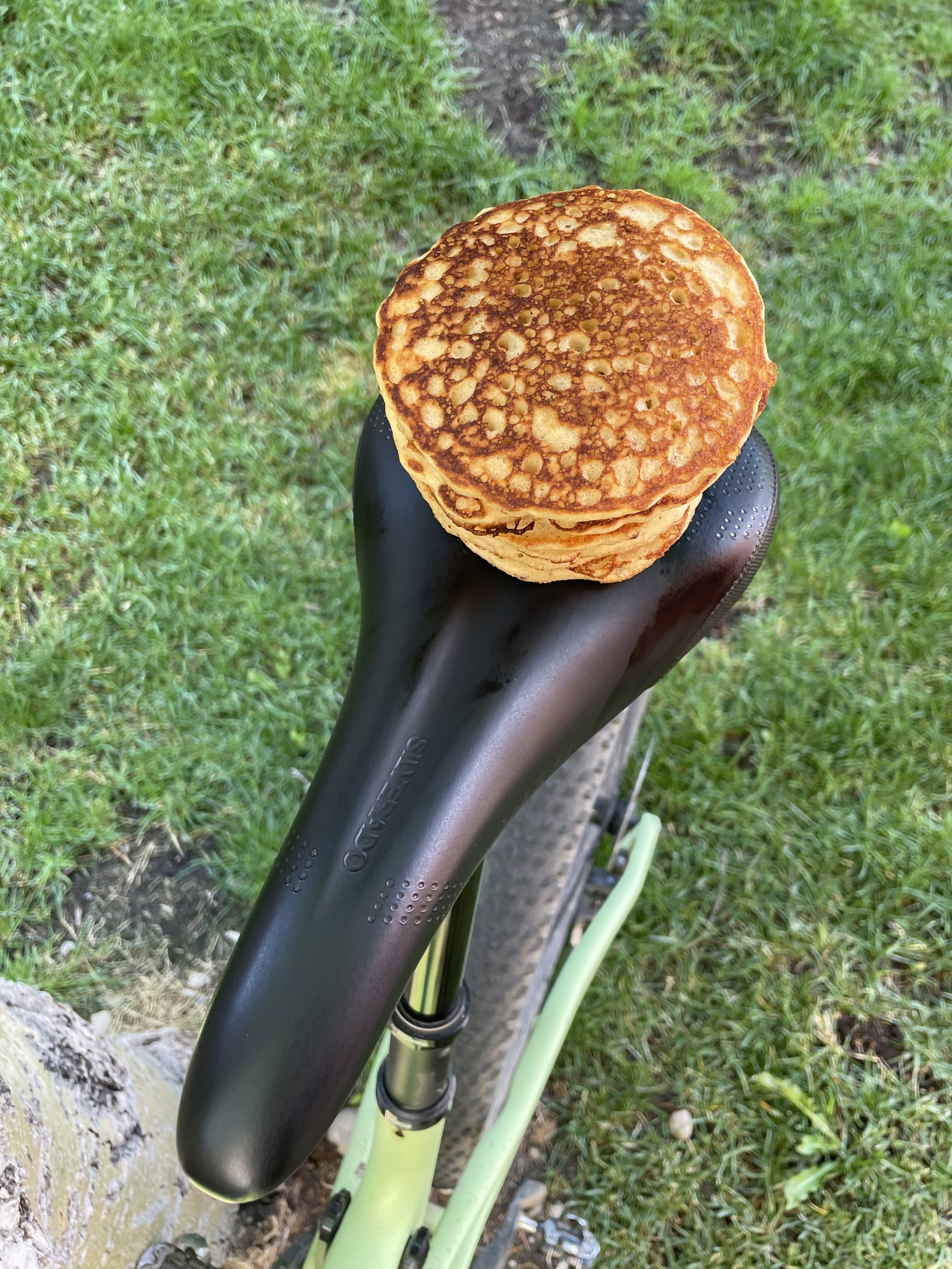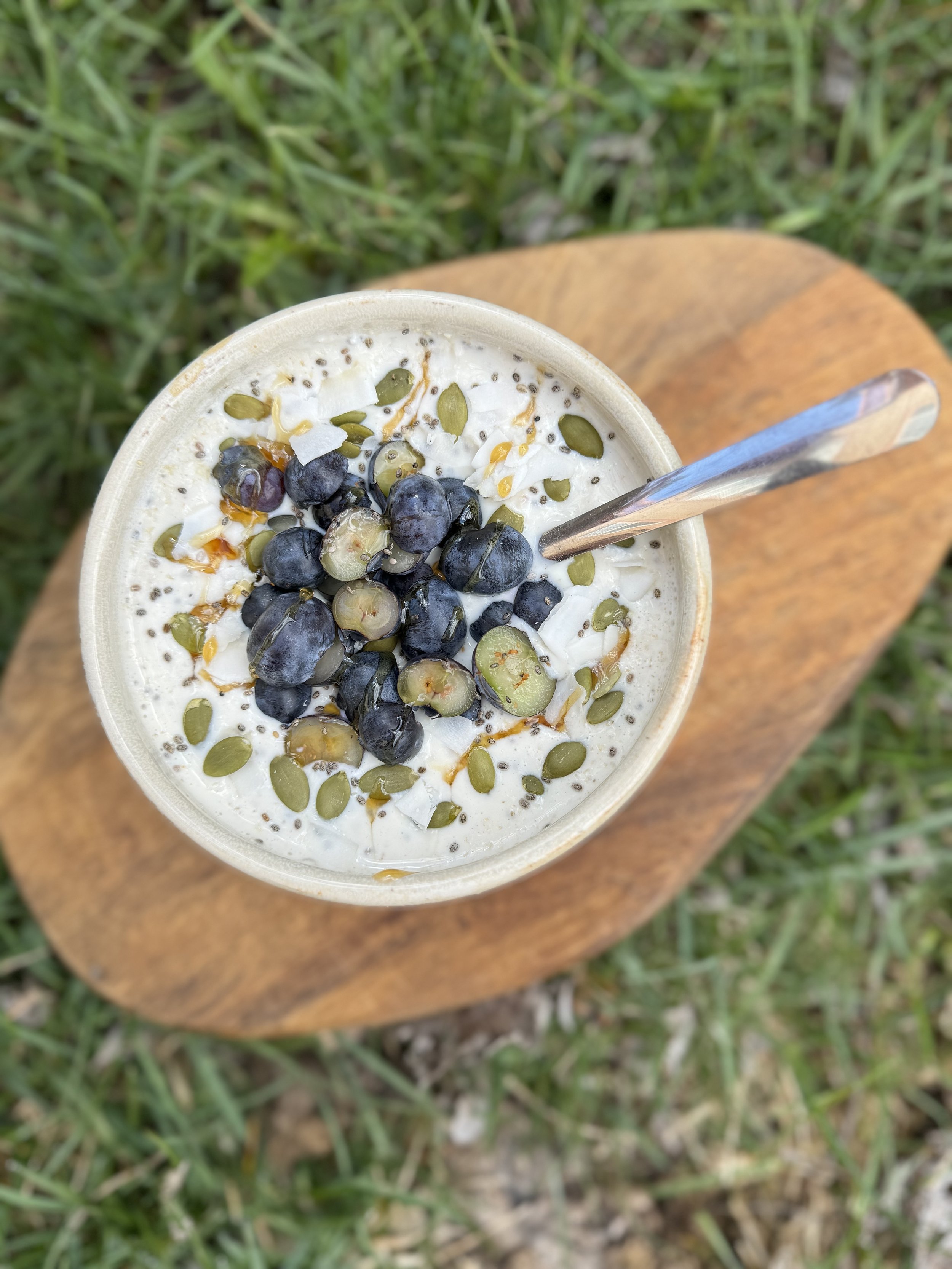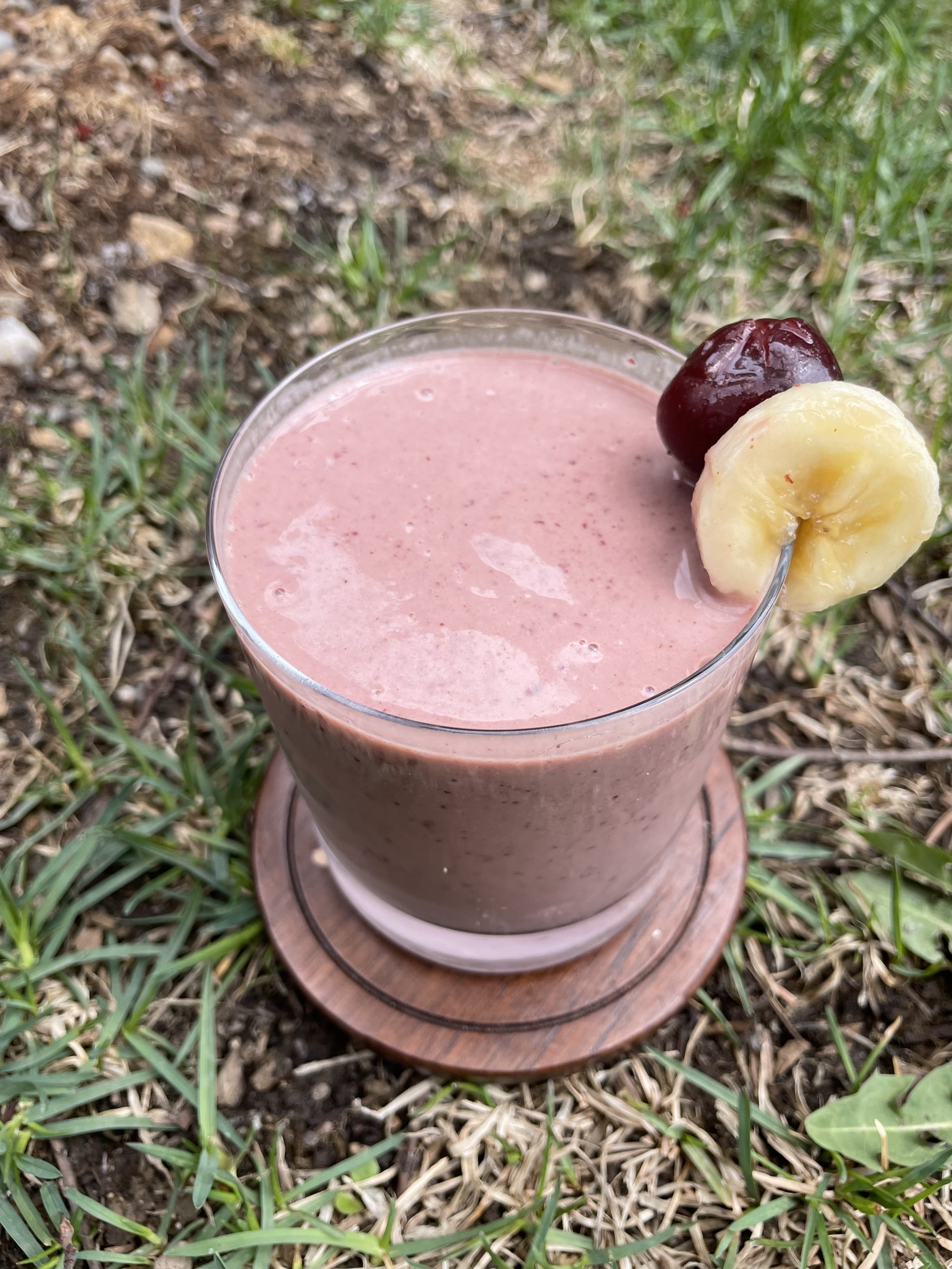Fueling for Performance: Pro Tips For What and How Much to Eat Before, During, and After Your Rides
Whether you're spinning through the neighborhood, tackling a weekend group ride, or chasing your own fitness goals, how you fuel can make a big difference in how you feel on and off the bike.
A solid, balanced nutrition plan that supports your overall energy needs is the foundation for better performance, faster recovery, and more enjoyable rides. Once that’s in place, you can start layering in more specific fueling strategies around your workouts to help you ride stronger and recover faster.
Carbs are still king when it comes to fueling moderate to high-intensity rides. They’re your body’s fastest and most efficient energy source, helping you go the distance, climb stronger, and bounce back quicker.
This guide breaks down some of the best research-backed tips and general fueling strategies to help you get the most out of your rides. You’ll learn how to time your nutrition based on the intensity and duration of your workout, what to eat before, during, and after a ride, and get cyclist-approved snack ideas and recipes to try.
When it comes to cycling, nutrition can have a big impact on performance, but there’s no one-size-fits-all approach. Everyone has different metabolisms, training demands, and personal preferences, which means what works for one rider might not work for another.
Use these guidelines as a starting point—but remember, the best fueling plan is the one that works for you. Test, tweak, and adjust as needed!
Pre-Ride Fueling Tips
Your goal before a ride is to top off your glycogen stores—your body’s preferred fuel for endurance efforts—so you can start strong and stay energized. Whether you’re heading out for a morning ride or hitting the road later in the day, what (and when) you eat beforehand can make a big difference in how you feel on the bike.
When to Eat and How Much
3-4 hours before your ride: Eat a full meal with 3-4g of carbs per kg of body weight, plus a little protein (10-20g). Keep fat and fiber low to aid digestion, especially if your ride will be high intensity.
60–90 minutes before your ride: Have a snack (25–50g) of mostly carbs and minimal fat/protein.
30 minutes or less before your ride: Go for something high in simple carbs (20–30g) and no fat/protein.
Pre-Ride Meal Ideas (3-4 hours before riding)
Muesli soaked in fruit juice with banana, maple syrup, and a small amount of nut butter
Two slices of toast with jam + scrambled eggs
White rice with soy sauce and a fried egg
Smoothie with fruit, oats, protein, and fruit juice
Pancakes or waffles with syrup and berries
Orzo pasta with lemon juice, a small drizzle of olive oil, and bell peppers
Pre-Ride Snack Ideas (60–90 minutes before riding)
Banana with honey or maple syrup
Bagel with jam or honey
Homemade energy bars
Small bowl of cereal/granola with fruit and milk
Should I Snack Before My Ride?
A pre-ride snack can be a game-changer, especially when your ride demands extra energy or if it’s been a while since your last meal. Here’s when you should consider adding a snack to your pre-ride routine:
Eat a snack 60-90 minutes before your ride containing 25–50g of carbs + low protein/fat if:
It’s been more than 2-ish hours since your last meal
Your ride is 60 minutes or longer at high intensity
Your ride is 90 minutes or longer at any intensity
Short on time?
If you're riding in 30 minutes or less and any of the snacking guidelines above apply, grab a simple carb-rich snack or drink with 20–30g of carbs and minimal/no protein or fat to avoid GI distress and ensure quick energy.
The closer you get to your ride, the simpler the food you should eat. Think easy-to-digest carbs with little to no fat or fiber. like fruit juice, bananas, energy gels, chews, fruit snacks, cereal, or rice cakes.
Pre-Ride Recipes
Bombin’ Blueberry Bircher (3-4 hours before a ride)
Serves 1
5 minutes prep, 20 minutes to soak
½ cup Classic DIY Muesli Mix or rolled oats (see Baker’s Tip below)
1 Tbsp quinoa flakes (substitute rolled oats)
½ cup Greek yogurt
½ cup unsweetened apple juice
½ cup milk of choice
1 tsp of chia seeds
1 Tbsp lemon juice (optional, to help with digestion)
Toppings
1 Tbsp pepitas
1 Tbsp unsweetened coconut flakes
1 Tbsp honey
½ cup fresh blueberries
Directions
Add muesli, quinoa flakes, yogurt, apple juice, milk, chia seeds, and lemon juice, if using, to a cereal bowl. Stir and let rest for 20 minutes at room temperature or store covered in the fridge overnight.
Top with pepitas, coconut flakes, honey, and fresh chopped blueberries. Enjoy!
Nutrition Facts: 1 Serving: 615 calories, 96g carbs, 18g fat, 26g protein
Baker’s Tip
Making your own homemade muesli mix is easy. To get started, follow The DIY Muesli Formula.
The Ultimate DIY Muesli Formula = 4 cups grains + 1 cup nuts/seeds + 1 cup dried fruit + optional seasoning.
By following this formula, you’ll get roughly 35-40g of carbs, 7-9g of fat, and 6-8g of protein per ½ cup serving of Muesli. A balanced way to start your ride!
Sweet Potato Almond Butter Cake (60-90 minutes before ride)
Makes 9 cakes
5 minutes prep, 25-30 minutes to bake
1 cup cooked sweet potato
½ cup almond butter
⅓ cup maple syrup
2 eggs
1 cup rolled oats
1 tsp vanilla extract
1 tsp ground cinnamon
¼ tsp fine sea salt
½ tsp baking soda
⅓ cup dried blueberries or cherries
Zest and juice of 1 lemon
Directions
Preheat the oven to 375°F. Grab an 8 x 8-inch square baking pan, a 12-tin brownie bar pan, or a 12-tin muffin pan and grease well or line.
Put all the ingredients except the dried blueberries in a high-speed blender. Blend until smooth.
Fold in the dried blueberries. Pour into your prepared pan and bake for 25-30 minutes or until a toothpick inserted into the middle comes out clean.
Store leftover cake covered in the fridge. Eat a slice 1-1.5 hours before a ride if you need something quick and don’t have enough time to get in a full meal.
Nutrition Facts: 1 Cake: 210 calories, 27g carbs, 10g fat, 5g protein
During-Ride Fueling Tips
If you’re riding under 90 minutes and had a good pre-ride meal or snack, you might not need to eat during it, but fueling even short or easy rides can help improve your endurance and performance over time. For rides longer than 75-90 minutes, you want to be eating on the bike to keep your energy levels steady and avoid bonking. (your pre-ride snack or meal doesn’t count!)
When and How Much to Eat
<60 minutes (any intensity): You may not need to eat, especially if you fueled well before—but I encourage you to experiment with eating 30g carbs during your ride and see how it impacts your performance.
75-90+ minutes (low/moderate intensity): Take in 40-60g carbs/per hour of training DURING training. That means that during a 2-hour ride, consume 80-120g of carbs.
75-90+ minutes (high intensity): Work up to eating 90g carbs/per hour of training DURING training. Keywords: work up to. Your gut is adaptable and can be trained, but it takes time.
Aim to replace 40-50% of the calories you burn in an hour with mostly carbs
For rides 3+ hours, add 5–10g of protein/hour to manage hunger
On-Bike Fuel Ideas
Homemade or store-bought energy gels, chews, squeezes
Pastry like cookies, scones, quick breads, or cookie bars
Pancakes or waffles
Medjool dates stuffed with almond butter
Portable baked bars or oat-based bites
White bread sandwich with jam or date syrup + a little cream cheese
Rice cakes
Hydration Sports drink with electrolytes
Banana French Toast Cakes
Makes 12
10 minutes prep, 20 minutes to bake
4 cups cubed bread tightly packed (French, sandwich, or sourdough)
1 cup unsweetened almond milk (substitute milk of choice)
3 eggs
2 ripe bananas
¼ cup maple syrup
¼ cup unsweetened orange juice
2 tsp vanilla extract
3 Tbsp all-purpose or brown rice flour
2 tsp ground cinnamon, plus more for sprinkling
Dash of ground nutmeg
Coconut sugar for sprinkling on top
Directions
Preheat the oven to 350°F. Line or lightly grease a 12-bar or 12-cup muffin pan.
Add cut and cubed bread to a large mixing bowl. In a large measuring cup, heat almond milk in the microwave on high for 1½ minutes. Then add in the eggs, bananas, maple syrup, orange juice, vanilla, flour, cinnamon, and nutmeg. Beat the mixture until the eggs become light in color.
Add egg mixture to the bread bowl and stir to fully coat the bread pieces. Let rest for 5 minutes.
Spoon batter into the bar or muffin pan tin. Top each cake with a sprinkle of extra coconut sugar and cinnamon. Bake for 20 minutes or until a toothpick inserted comes out clean.
Let cool. Store in an airtight container in the fridge or individually wrap and refrigerate or freeze until your next ride.
Nutrition Facts: 1 Cake: 175 calories, 33g carbs, 3g fat, 5g protein
Post-Ride Fueling Tips
What you eat after a ride can make or break your recovery. Your muscles are especially good at absorbing carbs and protein in the first couple of hours post-ride, which helps you repair muscle, restock glycogen, and bounce back stronger for your next session. A balanced meal or snack post-workout = faster recovery + better training adaptation.
When to Refuel
Within 30–45 minutes: If you’re not sitting down for a full meal within an hour of your ride, eat a carb-rich snack with a bit of protein.
Target ratio: Post ride-snacks/drinks should contain a 4:1 carb to protein ratio (e.g., 32g carbs + 8g protein)
Within 2 hours: Aim for a balanced recovery meal with:
1–1.2g of carbs per kg of body weight
20–30g of protein: Earlier is better, especially if you have another ride coming up soon.
Speedy Refueling (For <8 hours between rides): If you’ve got another training session/race coming up within 8 hours, aim for a high-carb refueling strategy:
Eat 1–1.2g carbs per kg of body weight every hour for 4 hours: Include small amounts of protein with each snack or mini-meal. This approach supports rapid glycogen replenishment so you’re ready to go again.
What to Eat
Post-Ride Snack Ideas (Great for the first 30–45 minutes)
Banana with peanut butter and a glass of chocolate milk
Yogurt with berries, honey, and granola
Energy bar + recovery shake
Smoothie with fruit, oats, soy/cow’s milk, and nuts/seeds
How to Build Your Post-Ride Meal Plate (within 2 hours)
50% carbs: rice, pasta, potatoes, quinoa, bread
25% protein: eggs, tofu, tempeh, Greek yogurt, beans
25% color: vegetables or fruit
Add healthy fats: avocado, olive oil, tahini, nut-based sauces
Tart Cherry and Banana Post-Ride Smoothie
Serves 2
Time 5 minutes prep
1 cup frozen tart cherries
1 ripe banana, frozen
¼ cup tart cherry juice
½ cup Greek yogurt
1 Tbsp almond butter
1 tsp vanilla extract
¼ tsp almond extract (optional)
¼ - ½ cup almond milk (or dairy-free milk of choice)
Directions
Add all ingredients to a high-powered blender and blend until smooth and creamy. Add more milk if necessary for a smoother, more liquid texture.
Nutrition Facts: 1 Serving: 200 calories, 37g carbs, 6g fat, 9g protein
Hydration Tips for Before, During & After Your Ride
Hydration isn’t just a during-the-ride thing—it plays a role at every stage of your fueling strategy. Staying on top of fluid and electrolyte intake helps keep your muscles firing, digestion smooth, and focus sharp, both on and off the bike. Even a 2% drop in hydration can lead to a noticeable dip in performance, so it pays to stay proactive.
Everyday Hydration (a.k.a hydration throughout the day)
Aim to drink half your body weight (lbs) in ounces of fluid daily
(e.g., 150 lbs = 75 oz water/day)Spread it out throughout the day—don’t just chug right before your ride.
Add a pinch of salt or a splash of citrus if you're a salty sweater or riding in heat.
Hydration Before Your Ride
Start sipping 16–20 oz of fluid 1–2 hours before you roll out
If it’s hot, humid, or a longer effort, consider an electrolyte drink beforehand
Hydration During Your Ride
Anytime you’re sweating, you are losing electrolytes. This means you should drink electrolytes, not just water, whenever you are sweating during your rides.
For rides over 60 minutes or in warm, humid weather: Drink 16–24 oz of fluid with electrolytes per hour
Sodium is the MVP here—helping with fluid absorption and preventing cramps
Use a sports hydration drink or electrolyte mix, or DIY one.
Hydration After Your Ride
Rehydrate based on your sweat losses (weighing yourself before/after can help if you want to get precise)
A good rule of thumb: drink 16–24 oz for every pound lost
Include electrolytes—especially sodium—to help your body retain the fluids you’re taking in
My Favorite Sports Hydration Products
Final Thoughts
Ensure total daily energy intake is adequate: This has to be the top priority. Total energy comes first, timing – and even composition – come after that.
Fueling for cycling is both an art and a science. Once you start tailoring your nutrition to your ride’s intensity and duration, you’ll feel the difference—in your legs, your energy, and your results. The key is consistency, preparation, and finding carb-rich snacks that you enjoy and can rely on ride after ride.
Need some help with ideas? Download my free e-recipe book packed with 50 portable snacks, energy gels, and on-bike smoothie recipes designed just for cyclists. Whether you’re chasing watts, conquering climbs, or cruising with friends, this guide has your fuel plan covered.










